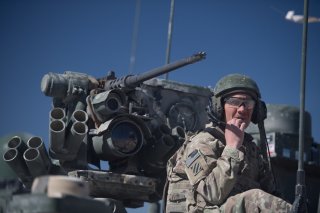The Army Is Rapidly Advancing Its Multi-Domain Attack Strategy
An entirely new sphere of technologies and multi-domain tactics are leading the Army to redefine its approach to traditional Combined Arms Maneuver warfare.
Picture Lockheed Martin F-35 Lightning II stealth fighters sending enemy force location detail to soldiers maneuvering on the ground, Army soldiers using ground-radar data to alert Air Force fighter jets and drones or Navy ships using ballistic missile defense technology to send threat specifics about incoming attacks to ground units. These are all scenarios increasingly being tested as part of the Army’s current emphasis upon multi-domain warfare. An entirely new sphere of technologies and multi-domain tactics are leading the Army to redefine its approach to traditional Combined Arms Maneuver warfare.
“Combined Arms Maneuver has got to be joint. This will evolve and it will become more rapid. The battlespace will expand based on robotics and space as cyberspace. We have to do this faster. We have to do it more efficiently so that we're making decisions that not only defeat our adversaries, but we're able to do it in such a manner that we can do it more rapidly than anyone on Earth,” Maj. Gen. Ross Coffman, Director for Next-Generation Combat Vehicles Cross-Functional Team, at the Army Futures Command, told the National Interest in an interview.
“So while you're looking for air threats we're also able to very quickly pick up those ground threads that might threaten the forces. Multi-domain sensing can be air, ground, or even littorals. We could put this on a boat or even a Navy vessel for those types of threats to those surface water threats. You know, it could even be used against pirates or some other small moving mass,” Rob Menti, Business Development Director at Northrop Grumman, told the National Interest from the demo in Arizona.
“It’s important to bring all of the effectors that are available to bear on different threats. You know, whether that's a drone or a ground system or whatever it might be... everybody's got to be on the network because being on the network is probably the key to survivability on tomorrow's battlefield,” Menti said.
Multi-domain connectivity can help fill in or eliminate “gaps” in radar defenses or sensors intended to find, track and target approaching enemy drones or ground targets. The concept is to network air, ground, and even maritime assets into a single ground of “meshed” nodes on an interconnected battlefield to ensure seamless, real-time targeting.
Kris Osborn is the defense editor for the National Interest. Osborn previously served at the Pentagon as a Highly Qualified Expert with the Office of the Assistant Secretary of the Army—Acquisition, Logistics & Technology. Osborn has also worked as an anchor and on-air military specialist at national TV networks. He has appeared as a guest military expert on Fox News, MSNBC, The Military Channel, and The History Channel. He also has a Master’s Degree in Comparative Literature from Columbia University.
Image: DVIDS

